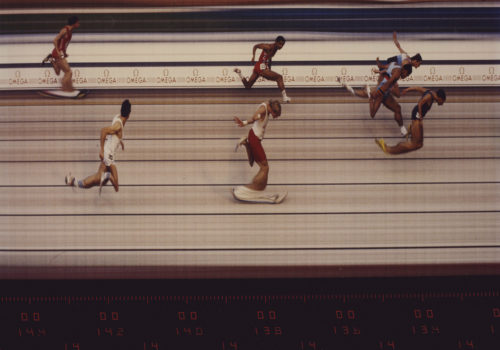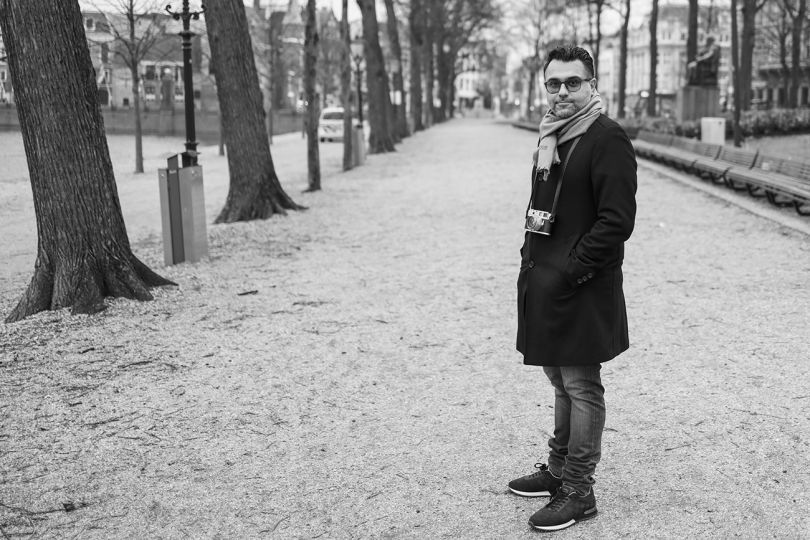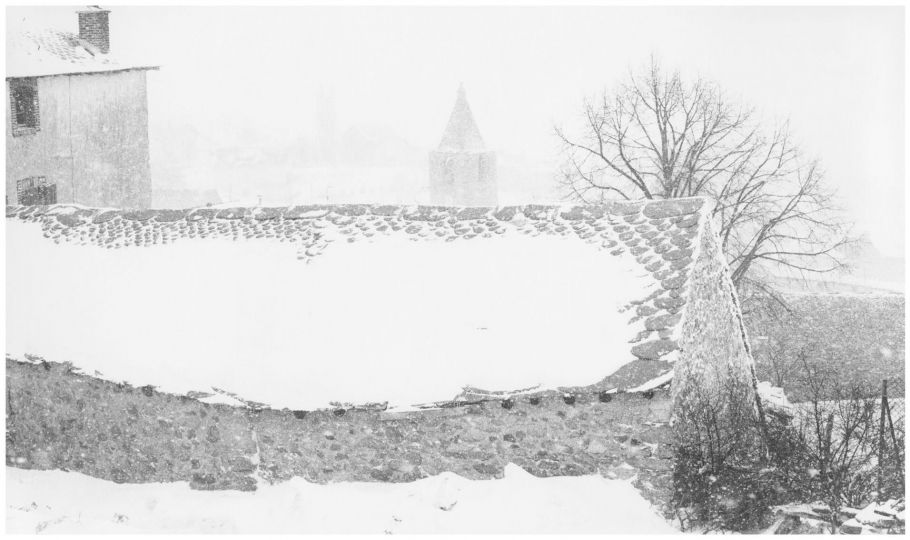Photography and watchmaking, the central techniques of Western modernity, are both based on the fine control of time. Literally and symbolically, they put time in a box. Their proximity is such that Roland Barthes spoke of photography as a “clock to see”. The fact remains that their intimate links have been surprisingly little considered until now.
Between the two world wars, faced with economic crises, Swiss watchmaking know-how found a diversification in the manufacture of cameras. From photography to watchmaking, there is certainly the step of optics and chemistry, but above all the common basis of precision mechanics with its cogs, springs, levers, counters, and millimetre fittings. From the Vallée de Joux to the Aargau, companies are starting to produce top-of-the-range cameras.
LeCoultre proposed the Compass (1937), a masterpiece of miniaturised technology, a feat with multiple functions. The Alpa de Pignons (1944) was a great international success in the post-war period, supported by the slogan “Swiss watchmakers camera”. The Michel pigeon camera (1937) is the forerunner of the drone camera: it allows low-level aerial shots for military reconnaissance missions. Siegrist’s Tessina (1960) is so compact that it can be worn on the wrist like a watch; it is one of the favourite devices of Cold War espionage. The photofinish was developed in the post-war period by Omega, Longines and soon Swiss Timing. More than ever relevant to sporting competitions, the photofinish turns photography into a veritable visual clock, capable of showing the stretching of time down to its most minute dimensions.
The exhibition invites you to this unprecedented exploration, accompanied by a rich publication by Editions Infolio, to be published at the end of February 2022. The publication includes case studies, thematic essays and an in-depth look at the relationship between photography and watchmaking. The exhibition and publication are the result of a research project conducted in close partnership with the University of Lausanne.
Two machines for the preservation of time
For almost two centuries, photographic theory has proclaimed that photography is an art of time. Yet surprisingly little consideration has been given to the intimate links it has with the age-old art of time measurement, watchmaking. Like the clock, the photographic camera is defined as a time-preserving machine and, like the clock also, its operation is based on a fine mastery of the division of time (…)
It is possible to establish a series of homologies between these two mechanisms that are capable, literally and symbolically, of boxing up time. Whether they are analogue or digital techniques, their components are often similar. The same materials and the same tools have been or are used in their manufacture. In parallel, they have incorporated the advances of electronics and then computers, which has led to a revolution in their uses and their markets, in both cases. They are also metaphorical machines that question, with equal force, our relationship with time and embody the transitory nature of human existence. The camera and the clock have also, in the same drive for precision, progressively split time to improve their efficiency, moving from the hour to the minute, then from the second to the tenth, hundredth or thousandth of a second.
With the shortening of exposure times, photography, long defined as the product of optics and chemistry, became just as much, from the end of the 19th century and the development of shutters, a highly mechanised technique, involving many cogs, springs, levers, counters and timers. It therefore increasingly called on companies specialising in precision mechanics. This was the case in Switzerland, the heart of world watchmaking in the 20th century, where, in the face of the crises of the inter-war period, photography was to appear as a privileged field for diversifying watchmaking know-how. As early as the 18th century, automata and music boxes had already put watchmaking mechanics at the service of the automated production of images and sounds, and in the 20th century, several Swiss companies perpetuated this tradition by turning to the manufacture of cameras, record players or recorders. A number of them chose above all to develop a remarkable series of top-of-the-range photographic cameras which, developed from the 1930s to the 1960s, were to mark the exchanges between the two fields in many ways.
(Luc Debraine and Olivier Lugon; extract from the introduction to the catalogue “Photography and watchmaking” to be published at the end of February 2022 by Infolio).
Compass, «Built like a watch»
Designed in the inter-war period by a British inventor, the Compass has the slogan «Built like a watch». Its manufacture was entrusted to the LeCoultre & Cie factory, today Jaeger-LeCoultre. The aluminium camera, as large as a packet of cigarettes, is a technological marvel. Equipped with a 35 mm lens and a rangefinder for focusing, the Compass was fitted with 24 x 36 plates, then later with film in rolls of 6 exposures produced by Ilford in Great Britain. It has built-in filters, a light meter, two viewfinders (one of which is right-angle), a ground glass viewfinder, a spirit level, and devices for panoramic and stereoscopic shooting. Its internal movements are of incomparable precision, as is the care given to the finishing of the device, with the Côtes de Genève also present on LeCoultre watch movements. The advertising for the Compass benefits from the expertise of the Lausanne agency Trio, a partner of the Le Sentier manufacture. Sold from 1937, the device saw its destiny come to a halt with the Second World War. In total, less than 5,000 of them were produced. Today it is highly sought after by collectors.
Alpa, «Swiss watchmakers camera»
The inventor Jacques Bogopolsky, who was also behind the Bolex cameras, proposed a 35 mm camera in the 1930s to the watchmaking company Pignons, established in Ballaigues in the Jura region of Vaud. The camera has the originality of having a double telemetric and reflex viewfinder. Pignons redesigned the entire case, then marketed it under the name Alpa in 1944. A clever prismatic viewfinder was proposed in 1949. In the 1950s, the peak of the Vaud brand, some sixty employees assembled up to 200 cameras per month. Alpa’s advertising took advantage of Switzerland’s aura of technical precision and reliability, as well as the fact that the products were manufactured by watchmaking specialists. The slogan «Swiss watchmaker camera» is self-evident. The luxury positioning of the brand is also an advantage. In the 1960s, Alpa suffered from Japanese competition before struggling to respond to the introduction of electronics in cameras. The brand tried to diversify its products (medical, reproduction, macro, underwater and panoramic photography) but did not avoid bankruptcy in 1990. The Alpa name was then bought by swiss entrepreneurs who launched a high-end medium format camera.
The Michel pigeon camera
In 1909, the German Julius Neubronner presented an automatic camera for carrier pigeons. Intended for both civilians and military surveillance, the device made use of a pneumatically triggered self- timer, as well as two lenses that captured two images per flight, soon replaced by a single pivoting lens. The device is attached to the bird’s chest with elastic straps. The German army gave up using it. In 1936, Adrian Michel from Aargau patented a similar camera, also with a military purpose. Michel ran a watchmaking company in Walde. He sought to diversify his production in a bad economic period.
His know-how enables him to design a mechanical time delay device inspired by watches, equipped with a spring, a gear train and an escapement system. The 70-gram camera can either take 6 to 7 photographs at 30-second intervals or 12 to 15 photographs at 15-second intervals. A mechanism resets the shutter and ensures that the pivoting lens returns to its initial position. Michel’s watchmaking expertise allows him to fit these many elements into a small case. The Swiss army will not be interested in the invention for pigeons. The production will be abandoned after the manufacture of a hundred units.
Tessina, in the service of espionage
In the early 1950s, the German engineer Rudolf Steineck developed a tiny wristwatch camera. Financial setbacks forced him to move to Ticino, where he worked on a miniature 35 mm camera that could fit into a cigarette packet. The case contained 300 small parts, and he entrusted its manufacture and assembly to the Siegrist watchmaking company in Grenchen, in the canton of Solothurn. The Tessina was launched in 1960.
Unlike its miniature competitor Minox, the camera uses standard 35 mm film which can be wound into a special cassette. A quasi clockwork movement automates the transport of the film and the arming of the shutter. The Tessina has two lenses on its side, one for aiming and one for shooting. It can accommodate a range of accessories, starting with a wrist strap that allows it to be worn on the wrist like a watch. Other accessories include a light meter, a magnifying glass, an image straightening prism, and a rectangular 17-jewel watch. The Tessina was used extensively during the Cold War by American, Soviet and East German intelligence services. It is one of the protagonists of Alfred Hitchcock’s film Topaz. He was found on one of the agents in charge of the Democratic Party burglary in Watergate, the affair that led to the fall of US President Richard Nixon. More than 20,000 units of the Tessina were produced until the 1990s.
Photofinish, photographic chronograph
The history of the Photofinish embodies the convergence of photography and watchmaking, brought together here with the aim of pushing back the limits of precision in the measurement of time. As early as the 19th century and the invention of the shutter, photography exceeded the speed of the human eye. It was quickly used to determine the winner of sporting competitions, starting with horse racing. From the 1940s onwards, particularly in Olympic competitions, Omega and Longines proposed equipment that integrated time measurement with image capture.
The photofinish is a continuous photographic recording, made by leaving the shutter of the camera open. The film runs at the same speed as the sports competitors past a slit aligned with the finish line. The result is a long strip of film on which it is possible to distinguish the precise moment when each competitor passes through the selected area. In other words, the gap between two competitors does not show a distance, but a time interval. The system aims to be objective, impartial and as accurate as possible. The cameras were initially analogue, making it necessary to develop the film before transmitting the results. Then electronics, video and digital technology constantly improved the system’s accuracy. Omega and Longines founded the company Swiss Timing in 1972, which later became part of the Swatch Group. Today, a Scan’O’Vision digital camera from Swiss Timing is capable of recording up to 10,000 images per second of each competitor crossing a finish line.
Photography and watchmaking
Du 20 janvier au 21 août 2022
Swiss Camera Museum – Vevey
Grande Place 99
1800 Vevey, Suisse
www.cameramuseum.ch
















